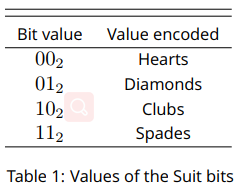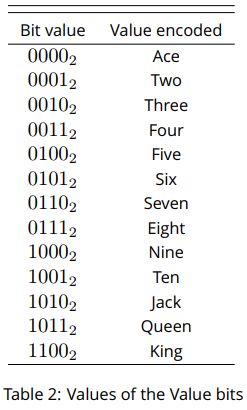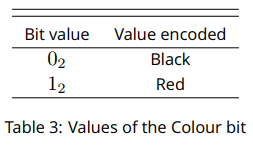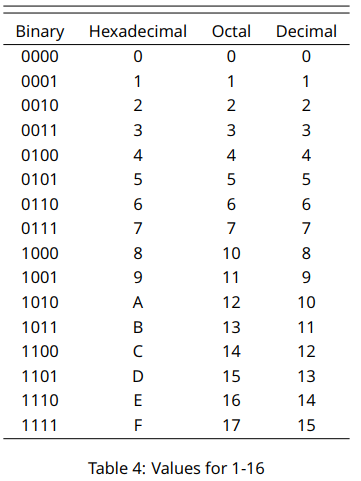Practical Case Study A
Operating Systems Programming (Advanced) – 300943
1 Introduction
Operating Systems have a need for extremely compact data structures, as often these need to be stored wholly in memory. Examples of this are free memory lists, page tables and disk space bitmaps. This Practical Case Study will refresh your knowledge of bit operations, necessary to manipulate such compact data-structures. We will use a simple variant of the card game poker as the inspiration for our compact data structure.
In this exercise you will model a deck of playing cards as a bit field. Only six bits are required to fully describe a card, two for the suit and four for the value. An extra bit as been added to the structure to encode the colour of the card.
A second bit field will be used to store the number of pairs contained in a hand. Read this section fully before attempting any of the exercises.
These instructions contain some background information, the task to perform, sample code and some system documentation extracts.
2 Structure of the bit fields
2.1 The card bit field
As explained above only six bits are really needed to describe a playing card. However a seventh bit has been added, this is only as a matter of convenience, as you will see below it makes the card 000000002 an invalid card and thus the standard C logic tests can be used to test if a card is valid or not. As only seven bits are required you can use one byte to store the value. A C type definition of:
typedef unsigned char card;
would be useful to describe this new data type, as we don’t treat it as a whole but as a bit set.
The byte will have the following format, bits 0 encodes the colour, bits 1, 2, 3, & 4 encode the value and bits 5 & 6 encode the suit. Bit 7 is unused. Each of these subsections has the values as depicted in Tables 1, 2 & 3.
Following this table the Ace of Hearts would be 00000012(1) and the King of Spades would be 011110002(120). You should draw a picture of what this bit field looks like, noting which of the 8 bits are assigned to which values.



2.2 The pairs bit field
The second bit field is used to hold the number of pairs in a hand. It has the format that the four least significant bits (bits 0-3) contain the number of pairs contained in a hand and the four most significant bits (bits 4-7) hold the value of the card as detailed in Table 2. A C typedef of:
typedef unsigned char pairs;
will be useful here. You should draw a picture of what this bit field looks like, noting which of the 8 bits are assigned to which values.
3 Bit Operations
The C programming language provides a full set of bit manipulation operators:
• & bitwise and
• | bitwise or
• ˆ bitwise exclusive or
• ˜ ones compliment
• >> right shift
• << left shift
These operators can be used to manipulate values at the bit level. There are four main operations that we perform, setting a bit, unsetting a bit, testing if a bit is set and toggling a bit.
To set a bit we use the bitwise or operator. To do this we bitwise or our value with a mask with the bits we want to turn on set to 1 and all others 0. For example to turn on the third bit our mask would b 000001002 (the subscript 2 means that the number is expressed in binary, no subscript means decimal).
To unset a bit we use the bitwise and operator. To do this we bitwise and our value with a mask with the bits we want to unset set to 0 and all others 1. For example to unset the sixth bit our mask would be 110111112. We can also use the ones compliment operator to invert a mask used to set a bit.
To test if a bit is set we use the bitwise and operator. To do this we bitwise and our value with a mask with the bits we want to test set to 1 and all others 0. For example to test if the fifth bit is set our mask would be 000100002.
To toggle a bit we use the bitwise exclusive or operator. To do this we bitwise exclusive or our value with a mask with the bits we want to toggle set to 1 and all others 0. For example to toggle the fourth bit our mask would be 000010002.
We can use the left shift operator to construct masks, by shifting the value 1 the required number of positions.
The shift operators can also be used, with masking to extract subfields or to encode subfields.

4 Number Systems
In the previous section various masks were presented, however the C programming language doesn’t allow numbers to be expressed in binary. C allows three styles of number: decimal, octal and hexadecimal. Decimal numbers are the numbers we use every day.
Octal numbers are a base 8 system. To specify to the C compiler that a number is octal you add the prefix 0. For example the decimal number 23 would be written in octal in a C program as 027. The advantage of octal numbers is that each digit represents exactly three bits. Octal numbers are often used for specifying permissions in Unix.
Hexadecimal numbers are a base 16 system, the letters a-f or A-F are used for the extra positions. To specify to the C compiler that a number is hexadecimal you add the prefix 0x. For example the decimal number 23 would be written in hexadecimal in a C program as 0x17. The advantage of hexadecimal numbers is that each digit represents exactly four bits. Hexadecimal numbers are often used for specifying masks and memory addresses.
Table 4 shows equivalent values for the numbers 1-16.
5 Programming Tasks
You should begin by reading the example code carefully. It contains some hints and comments on where to fill in the blanks.
The first step will be writing a function that displays the card. You can use the various bit fields as an index to an array of strings once extracted. The arrays are:
static char *suits[] = {"Hearts","Diamonds",static char *values[]= {"Ace","Two","Three","Four","Clubs","Spades"};
static char *colour[]= {"Black","Red"};"Five","Six","Seven","Eight","Nine","Ten","Jack","Queen","King"};
You should print the card as “Ace of Hearts, is Red”, with one card per line. Test your function by creating cards individually and displaying them.
Once you can display cards you should then write a function that populates a deck (array of 52) with cards. The deck should be sorted in order by suit, that is Ace to King of hearts, then diamonds etc. With some clever arithmetic you can accomplish this in one pass of the deck. Print the deck once you have populated it.
Once you have a deck, develop a method for shuffling it. As a hint investigate the C standard library functions rand() and srand(). Shuffling involves mixing the cards up so that the order is random. Print the deck a second time and check that you have actually mixed up the deck.
Now that we have a working shuffling algorithm we are ready to play cards. To keep things reasonably simple we are going to simulate a simplified version of poker. In this game 5 hands of five cards are dealt. There is no swapping of cards and the winner is determined by who has the highest pair. A pair of cards are cards that have the same value e.g. the Ace of Hearts and the Ace of Spades are a pair. The number of pairs contained in a hand, three or four of a kinds have no bearing on the result. If none of the five hands contains a pair, or two hands contain the same highest pair, the game is considered drawn.
Although traditional poker has the Ace card being a turning point, that is it can be the low card or the high card, the cards in this game have a fixed order, as described in Table 2. This means that Aces are low and can be beaten by any other pair.
You should develop a program that implements this game. Additionally you should print each of the hands sorted in order of value, print the number of pairs in each hand and if there is at least 1 pair print the value of the highest pair. Once all five hands have been printed you should indicate if there was a winner and the value of the pair that won. If there was no winner you should indicate that the game was drawn. See Figures 1 & 2 for some sample output.
Your hands should be stored in an array for ease of use and when sorting the hand you should investigate the C standard library function qsort(), which might make things easier for you.
Hand 1:
Six of Spades, is Black
Seven of Diamonds, is Red
Eight of Spades, is Black
Ten of Hearts, is Red
Queen of Spades, is Black
Number of pairs: 0
Hand 2:
Three of Spades, is Black
Five of Diamonds, is Red
Five of Clubs, is Black
Nine of Diamonds, is Red
Queen of Diamonds, is Red
Number of pairs: 1
Highest pair is: Five
Hand 3:
Three of Clubs, is Black
Seven of Hearts, is Red
Nine of Clubs, is Black
Jack of Clubs, is Black
Jack of Spades, is Black
Number of pairs: 1
Highest pair is: Jack
Hand 4:
Two of Diamonds, is Red
Four of Spades, is Black
Seven of Clubs, is Black
Eight of Diamonds, is Red
King of Hearts, is Red
Number of pairs: 0
Hand 5:
Ace of Hearts, is Red
Six of Clubs, is Black
Seven of Spades, is Black
Nine of Spades, is Black
Nine of Hearts, is Red
Number of pairs: 1
Highest pair is: Nine
Winner is hand 3 with a pair of Jacks
Figure 1: Example output of a game with a winner. (The output has been wrapped to two columns to fit on the page.)
Hand 1:
Three of Clubs, is Black
Five of Hearts, is Red
Seven of Spades, is Black
Queen of Clubs, is Black
King of Spades, is Black
Number of pairs: 0
Hand 2:
Three of Diamonds, is Red
Five of Diamonds, is Red
Seven of Hearts, is Red
Queen of Diamonds, is Red
King of Hearts, is Red
Number of pairs: 0
Hand 3:
Ace of Hearts, is Red
Two of Clubs, is Black
Seven of Diamonds, is Red
Nine of Spades, is Black
Jack of Clubs, is Black
Number of pairs: 0
Hand 4:
Ace of Clubs, is Black
Five of Clubs, is Black
Nine of Diamonds, is Red
Jack of Diamonds, is Red
King of Clubs, is Black
Number of pairs: 0
Hand 5:
Three of Hearts, is Red
Four of Hearts, is Red
Ten of Hearts, is Red
Queen of Hearts, is Red
King of Diamonds, is Red
Number of pairs: 0
Drawn game
Figure 2: Example output of a game without a winner. (The output has been wrapped to two columns to fit on the page.)
6 Marking Scheme
The following functionality items will be considered when evaluating how much of the specification is implemented:• Printing a card
• Filling the deck
• Shuffling the deck
• Dealing the hands
• Sorting the hands
• Printing the hands
• Determining the number of pairs in a hand (Note: Three of a kind is one pair, and four of a kind is two pairs).
• Determining the value of the highest pair in a hand
• find_pairs() returns a correct value for the pairs data type
• Determining if there is a winner or a draw
The following rubric, taken from the learning guide (with zero weighted criteria removed), will be used to evaluate submissions.

7 Sample Code
This sample code is also available at the unit website. You may not need all the variables declared in this code and you may choose to add more.
#include<stdio.h>
#include<stdlib.h>
#include<time.h>
/* handy typedefs */
typedef unsigned char card;
typedef unsigned char pairs;
/* arrays for the names of things */
static char *suits[] = {"Hearts","Diamonds","Clubs","Spades"};
static char *values[]= {"Ace","Two","Three","Four","Five","Six",\
"Seven","Eight","Nine","Ten","Jack",\
"Queen","King"};
static char *colour[]= {"Black","Red"};
/* function prototypes */
void printcard(card c); /* Displays the value of a card*/
void printdeck(card deck[52]); /* prints an entire deck of cards*/
void filldeck(card deck[52]); /* Populates a deck of cards */
void shuffle(card deck[52]); /* Randomizes the order of cards */
int compareface(const void* c1,const void *c2);
/* compares the face value of 2 cards, suitable to pass to qsort
as the fourth argument */
pairs findpairs(card *hand); /* finds any pairs in a hand */
int main()
{
card deck[52],*deckp;
card hands[5][5],handssorted[5][5];
pairs numpairs[5],highest;
int hand,cd,winner;
srand(time(NULL)); /* seed the random number generator */
/* remove this to get your program to work */
printf("You forgot to remove the stub to mask the fact\n");
printf("that the example code does nothing!!\n");
exit(0);
/*populate and shuffle the deck */
filldeck(deck);
printdeck(deck);
shuffle(deck);
printdeck(deck);
for(cd=0;cd<5;cd++)
{
for(hand=0;hand<5;hand++)
{
/* deal the hands here */
}
}
for(hand=0;hand<5;hand++)
{
/* sort the hands here */
numpairs[hand]=findpairs(handssorted[hand]);
printf("Hand %i:",hand+1);
/* print the hands here */
/* print the number and value of any pairs here */
} /
* determine the winner and print it */
return 0;
}
pairs findpairs(card *hand)
{
pairs numpairs=0;
/* find the pairs here */
return numpairs;
}
void filldeck(card deck[52])
{
/* populate the deck here */
return;
}
void printdeck(card deck[52])
{
int i;
for(i=0;i<52;i++)
printcard(deck[i]);
return;
}
void printcard(card c)
{
/* print the value of the card here */
return;
}
void shuffle(card deck[52])
{
int i,rnd;
card c;
for(i=0;i<52;i++)
{
/* generate a random number between 0 & 51 */
rnd=rand() * 52.0 / RAND_MAX;
/* finish shuffling the deck here */
}
return;
}
int compareface(const void* c1, const void *c2)
{ /
* This function extracts the two cards face values
and returns 1 if cd1 > cd2, 0 if cd1 == cd2, and
-1 otherwise. The weird argument types are for
compatibility with qsort(), the first two lines
decode the arguments back into "card".
*/
card cd1,cd2;
cd1=*((card*) c1);
cd2=*((card*) c2);
cd1= (cd1&0x1e)>>1;
cd2= (cd2&0x1e)>>1;
if(cd1>cd2)
return 1;
if(cd1==cd2)
return 0;
return -1;
}
8 rand() Manual Page
This manual page is taken from the Linux man-pages Project available at http://www. kernel.org/doc/man-pages/.
Name
rand, rand r, srand - pseudo-random number generator
Synopsis
#include <stdlib.h>int rand(void);
int rand r(unsigned int *seedp);
void srand(unsigned int seed);
Description
The rand() function returns a pseudo-random integer between 0 and RAND MAX.
The srand() function sets its argument as the seed for a new sequence of pseudo-random integers to be returned by rand(). These sequences are repeatable by calling srand() with the same seed value.
If no seed value is provided, the rand() function is automatically seeded with a value of 1.
The function rand() is not reentrant or thread-safe, since it uses hidden state that is modified on each call. This might just be the seed value to be used by the next call, or it might be something more elaborate. In order to get reproducible behaviour in a threaded application, this state must be made explicit. The function rand r() is supplied with a pointer to an unsigned int, to be used as state. This is a very small amount of state, so this function will be a weak pseudo-random generator. Try drand48 r(3) instead.
Return Value
The rand() and rand r() functions return a value between 0 and RAND MAX. The srand() function returns no value.
Example
POSIX 1003.1-2003 gives the following example of an implementation of rand() and srand(), possibly useful when one needs the same sequence on two different machines.
static unsigned long next = 1;
/* RAND_MAX assumed to be 32767 */
int myrand(void) {
next = next * 1103515245 + 12345;
return((unsigned)(next/65536) % 32768);
}
void mysrand(unsigned seed) {
next = seed;
}
Notes
The versions of rand() and srand() in the Linux C Library use the same random number generator as random() and srandom(), so the lower-order bits should be as random as the higher-order bits. However, on older rand() implementations, and on current implementations on different systems, the lower-order bits are much less random than the higher-order bits. Do not use this function in applications intended to be portable when good randomness is needed.
FreeBSD adds a function
void sranddev(void);
that initializes the seed for their bad random generator rand() with a value obtained from their good random generator random(). Strange.
In Numerical Recipes in C: The Art of Scientific Computing (William H. Press, Brian P. Flannery, Saul A. Teukolsky, William T. Vetterling; New York: Cambridge University Press, 1992 (2nd ed., p. 277)), the following comments are made: “If you want to generate a random integer between 1 and 10, you should always do it by using high-order bits, as in
j=1+(int) (10.0*rand()/(RAND_MAX+1.0));
and never by anything resembling
j=1+(rand() % 10);
(which uses lower-order bits).”
Random-number generation is a complex topic. The Numerical Recipes in C book (see reference above) provides an excellent discussion of practical random-number generation issues in Chapter 7 (Random Numbers).
For a more theoretical discussion which also covers many practical issues in depth, please see Chapter 3 (Random Numbers) in Donald E. Knuth’s The Art of Computer Programming, volume 2 (Seminumerical Algorithms), 2nd ed.; Reading, Massachusetts: Addison-Wesley Publishing Company, 1981.
Conforming to
The functions rand() and srand() conform to SVID 3, BSD 4.3, ISO 9899, POSIX 1003.1-2003.The function rand r() is from POSIX 1003.1-2003.
See Also
drand48(3), random(3)
9 qsort() Manual Page
Name
qsort - sorts an array
Synopsis
#include <stdlib.h>void qsort(void *base, size t nmemb, size t size,
int(*compar)(const void *, const void *));
Description
The qsort() function sorts an array with nmemb elements of size size. The base argument points to the start of the array.The contents of the array are sorted in ascending order according to a comparison function pointed to by compar, which is called with two arguments that point to the objects being compared.
The comparison function must return an integer less than, equal to, or greater than zero if the first argument is considered to be respectively less than, equal to, or greater than the second. If two members compare as equal, their order in the sorted array is undefined.
Return Value
The qsort() function returns no value.Conforming to
SVID 3, POSIX, BSD 4.3, ISO 9899
Note
Library routines suitable for use as the compar argument include strcmp, alphasort, and versionsort.Example
For an example of use, see the example on the bsearch(3) page.See Also
sort(1), alphasort(3), strcmp(3), versionsort(3)
2019-11-28